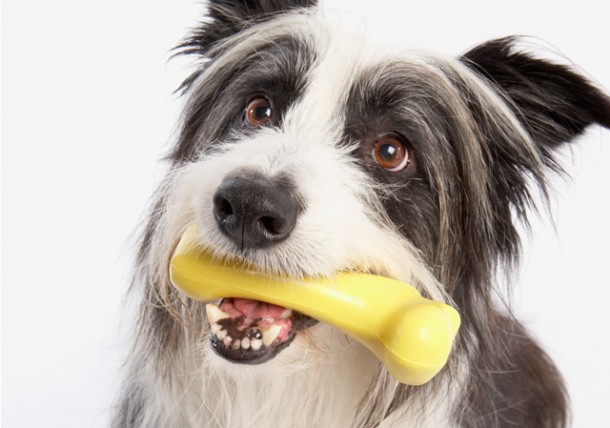Choosing What Your Dog Chews!

For our pets’ dental home care, we know brushing is best, but even I don’t brush my pets’ teeth every day! On the days when you can’t brush or if you have a pet that makes brushing challenging, it can be helpful to give them appropriate dental chews.
But with all the products out there, how do you choose the right chew?
Raw Products May Damage Teeth
First, make sure you pick a safe product. Be cautious of raw products, and remember many items are so hard and bulky that dogs can break their teeth on them. Bones, cow hooves, antlers and hard-compressed products (rawhide or plastic) are hard enough to damage the teeth. Bones in particular may splinter and cannot only damage the mouth and teeth but could damage the intestines if swallowed. It’s not helpful to remove tartar if part of the tooth is removed with it.
If it’s not compressible, bendable or you can’t indent it with your thumbnail, it could cause some damage if your dog is a heavy chewer. Something with a flatter shape doesn’t allow the dog to concentrate all of their biting force on their carnassial or crunching teeth. For a larger rawhide product, soaking it in water can give it some compressibility.
Make Sure It’s Effective in Dental Cleanings
Watch your dog with a new chew or product to ensure it’s not causing any damage. Effectively reducing plaque and tartar corresponds with the length of time it takes the dog to chew the object or how the object or treat holds together to help clean the tooth surface during the process. If the dog swallows the treat whole, it will not be effective in mechanically removing plaque. Also, you don’t want your pet chewing off chunks so large that it can choke. Some products and diets delay the hardening of soft plaque on the tooth surface, which would turn into tartar.
Consider the contents of the chew. There are some dogs that are sensitive to rawhide products, the preservatives in them or another component in the item. If it is a consumable product, you might need to start counting the calories if your pet is watching its waistline.
Your veterinary team is an excellent source for finding the right chews for your pet. They will often carry some products with which they have experience and confidence. Another resource to evaluate home care items is the Veterinary Oral Health Council, which has a list of products that have been tested and have seen a reduction of plaque and/or tartar (www.VOHC.org).
With all the choices available, take time to make wise decisions and let your veterinary health team help you. Good home care, including regular brushing and appropriate chewing items, can help your pet’s dental and oral health.
Dr. Heidi Lobprise, DAVDC (Diplomate, American Veterinary Dental College), practices dental specialty at Main Street Veterinary Hospital.

